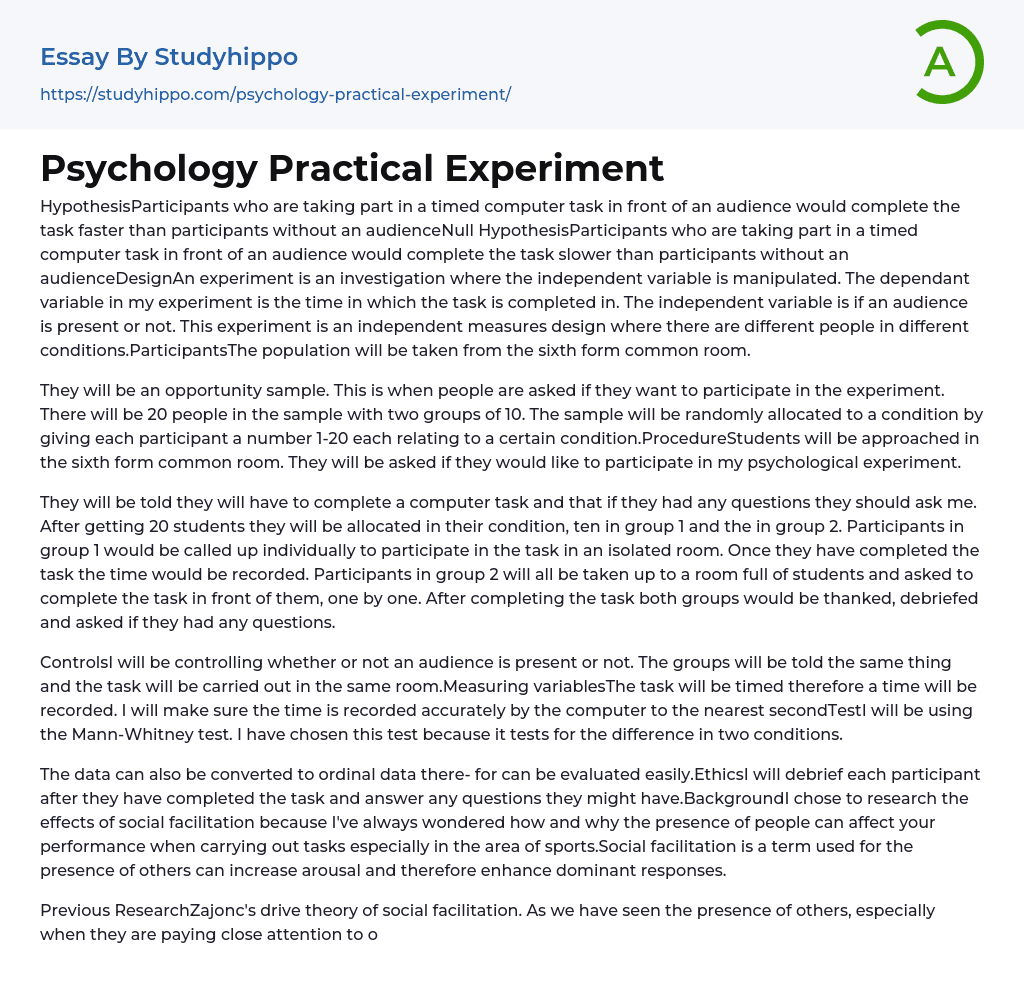The hypothesis suggests that participants who perform a timed computer task with an audience will complete it faster than those without an audience. Conversely, the null hypothesis states that participants with an audience will take longer to finish the task compared to those without.
To test this hypothesis, we will conduct an experiment using the presence of an audience as the independent variable and the time taken to complete the task as the dependent variable. This experiment employs an independent measures design where different individuals are assigned to different conditions.
For participant selection, we will use an opportunity sample from the sixth form common room. This entails asking individuals in the common room if they would like to participate in the experiment.
There will be 20 participants in total, divided into two groups o
...f 10. The allocation to a specific condition will be random, with each participant assigned a number from 1 to 20. The procedure includes approaching students in the sixth form common room and asking them to participate in a psychological experiment. They will be informed that they need to complete a computer task and any inquiries should be directed towards me.
After choosing 20 students, they will be divided into two groups. Group 1 will consist of ten students and group 2. In group 1, each participant will be summoned individually to a separate room where they will complete a task while their time is recorded. Conversely, participants in group 2 will enter a room with other students and receive instructions to perform the task one by one in front of everyone.
After completing the task, both groups will be thanked, debriefed, and asked if they hav
any questions. I will control whether or not there is an audience present. Both groups will be given the same instructions and the task will take place in the same room.
As part of measuring variables, the task will be timed and the time will be accurately recorded by the computer to the nearest second.
I chose to analyze the results using the Mann-Whitney test because it specifically tests for differences between two conditions.
The data can be easily converted to ordinal data for evaluation. Ethics are important, so I will debrief each participant and answer any questions after they complete the task. The research focuses on how the presence of people affects performance, particularly in sports, and examines the effects of social facilitation. Social facilitation occurs when others' presence increases arousal and enhances dominant responses. Previous studies, including Zajonc's drive theory, suggest that the presence of others, especially when they pay attention as an interested audience, results in increased arousal. According to Zajonc's theory, this heightened arousal leads to dominant responses that can be either correct or incorrect.
The study revealed that individuals with greater skills outperform those with less skill in a given task. The participants in this study were instructed to repeatedly pronounce words, some of which had more prominence than others. The frequency at which the words were displayed increased, and the participants had to quickly guess the word being shown. The results indicated that when an audience was present, the participants were more inclined to guess the prominent words. Allport conducted another experiment where participants were asked to write down associations for words on a blank sheet of paper. They completed this task either
alone or in front of two other individuals, and it became evident that when working in the presence of others, 93% of the participants generated a higher number of associations. In a separate investigation by Zajonc, cockroaches underwent training to move towards a light within a t-maze. Below the maze, there was a box where their fellow cockroaches could observe them and possibly detect their scent.
'Roaches displayed faster and more accurate performance in their t-mazes when surrounded by other 'roaches compared to when no audience was present.
- Abnormal Psychology essays
- Social Psychology essays
- Developmental Psychology essays
- Jean Piaget essays
- Positive Psychology essays
- Classical Conditioning essays
- Counseling essays
- Psychoanalysis essays
- Educational Psychology essays
- Behaviorism essays
- Authority essays
- Operant Conditioning essays
- Maslow's Hierarchy Of Needs essays
- Mental Health essays
- Personality Psychology essays
- Psychotherapy essays
- Family Therapy essays
- Stanford Prison Experiment essays
- Abraham Maslow essays
- Erik Erikson essays
- Cognitive Psychology essays
- Sigmund Freud essays
- Attachment Theory essays
- Supersize Me essays
- Individual essays
- Infant essays
- Childhood essays
- Adolescence essays
- Growth Mindset essays
- Is Google Making Us Stupid essays
- Childhood Memory essays
- Positive Attitude essays
- Reinforcement essays
- Archetype essays
- Maturity essays
- Deception essays
- Certainty essays
- Conformity essays
- Aggression essays
- Behavior essays
- Human Behavior essays
- Obedience essays
- Adult essays
- Procrastination essays
- Morality essays
- Altruism essays
- Human Sexuality essays
- Role Model essays
- Perseverance essays
- Expressive essays




